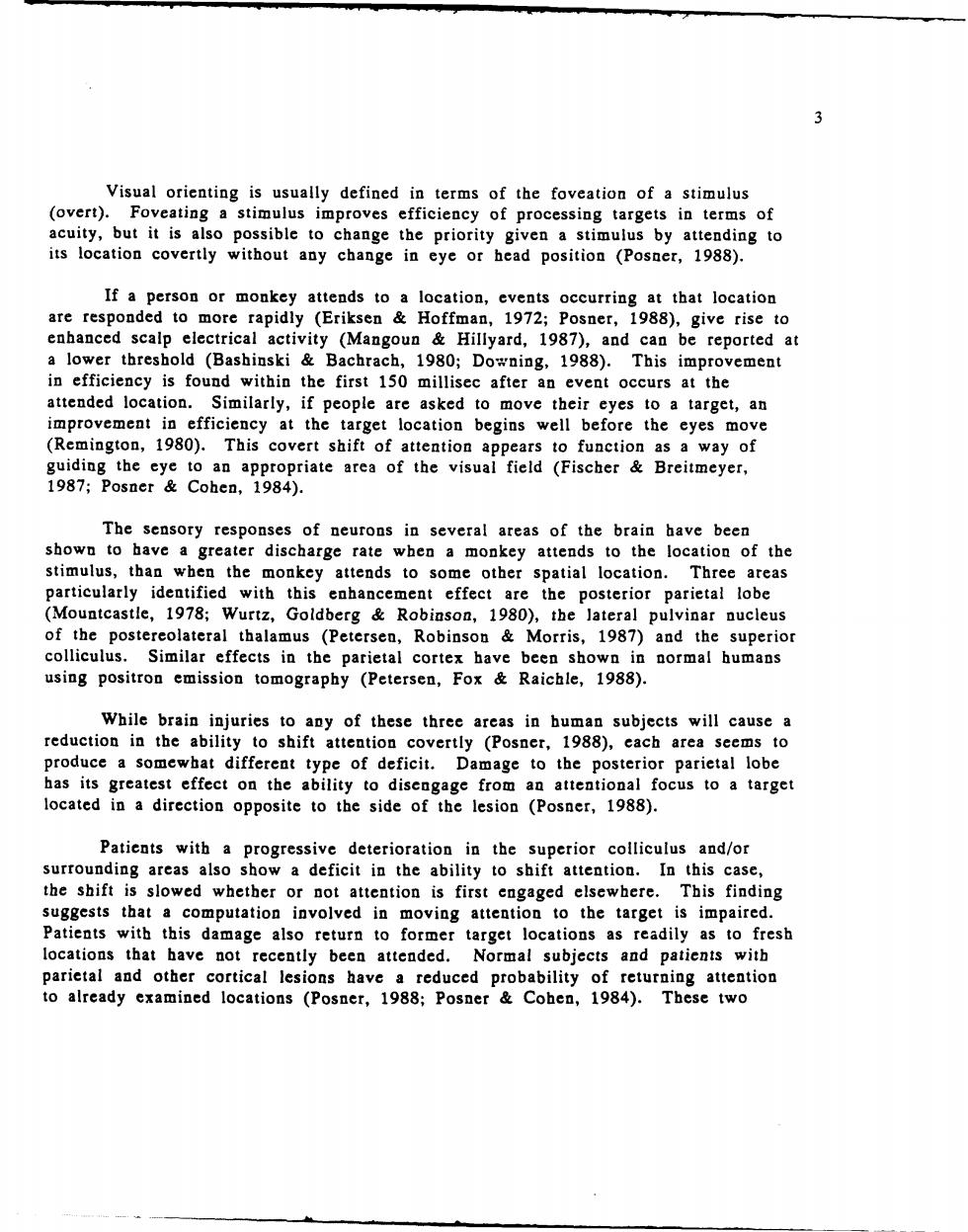正在加载图片...

Visual orienting is usually defined in terms of the foveation of a stimulus (overt).Foveating a stimulus improves effici acy of pr or head position (Posmer,1988). If a person or monkey attends to a location,events occurring at that location are responded to more rapidly (Eriksen Hoffman,1972;Posner,1988),give rise to emhanced scalp electrical activity (,1987).be reporteda a lower threshold (Bashinski Bachrach.1980:Do ing,1988). This in efficiency is found within the first 150 millisec an rs a attended location.Similarly people are ed to m eye target,an improvement in efficiene .th rge begins wel (Remin gton,1980).This e cyes mo the cove rt shif a 1 idin。 ention appear 9 a way of 9s7oaer hen, of neurons in several areas shown to hay of the brain have been when a mor stimulus,than grea arge rat key atten to the location of the cy att effe other to son articularly spatial locati with th 1978 Goldberg& inson,19 30),the lateral pulvinar nucleus thalamus (Petersen,Robinson Morris,1987)and the superior ilar effects in the parietal cortex have been shown in normal humans using positron emission tomography (Petersen,Fox Raichle.1989). While brain injuries to any of these three areas in buman subjects will cause a reduction in the ability to shift attention covertly (Posner,1988),cach area seems to produce a somewhat different type of deficit.Damage to the posterior parietal lobe has its greatest effect on the ability to disengage from an attentional focus to a target located in a direction opposite to the side of the lesion (Posner,1988). Patients with a progressive deterioration in the superior colliculus and/or surrounding areas also show a deficit in the ability to shift attention.In this case, the shift is slowed whether or not attention is first engaged elsewhere.This finding suggests that a computation involved in moving attention to the target is impaired. Patients with this damage also return to former target locations as readily as to fresh locations that have not recently been attended.Normal subjects and patients with parietal and other cortical lesions have a reduced probability of returning attention to already examined locations (Posner,1988;Posner&Cohen,1984).These two 3 Visual orienting is usually defined in terms of the foveation of a stimulus (overt). Foveating a stimulus improves efficiency of processing targets in terms of acuity, but it is also possible to change the priority given a stimulus by attending to its location covertly without any change in eye or head position (Posner, 1988). If a person or monkey attends to a location, events occurring at that location are responded to more rapidly (Eriksen & Hoffman, 1972; Posner, 1988), give rise to enhanced scalp electrical activity (Mangoun & Hillyard, 1987), and can be reported at a lower threshold (Bashinski & Bachrach, 1980; Downing, 1988). This improvement in efficiency is found within the first 150 millisec after an event occurs at the attended location. Similarly, if people are asked to move their eyes to a target, an improvement in efficiency at the target location begins well before the eyes move (Remington, 1980). This covert shift of attention appears to function as a way of guiding the eye to an appropriate area of the visual field (Fischer & Breitmeyer, 1987; Posner & Cohen, 1984). The sensory responses of neurons in several areas of the brain have been shown to have a greater discharge rate when a monkey attends to the location of the stimulus, than when the monkey attends to some other spatial location. Three areas particularly identified with this enhancement effect are the posterior parietal lobe (Mountcastle, 1978; Wurtz, Goldberg & Robinson, 1980), the lateral pulvinar nucleus of the postereolateral thalamus (Petersen, Robinson & Morris, 1987) and the superior colliculus. Similar effects in the parietal cortex have been shown in normal humans using positron emission tomography (Petersen, Fox & Raichle, 1988). While brain injuries to any of these three areas in human subjects will cause a reduction in the ability to shift attention covertly (Posner, 1988), each area seems to produce a somewhat different type of deficit. Damage to the posterior parietal lobe has its greatest effect on the ability to disengage from an attentional focus to a target located in a direction opposite to the side of the lesion (Posner, 1988). Patients with a progressive deterioration in the superior colliculus and/or surrounding areas also show a deficit in the ability to shift attention. In this case, the shift is slowed whether or not attention is first engaged elsewhere. This finding suggests that a computation involved in moving attention to the target is impaired. Patients with this damage also return to former target locations as readily as to fresh locations that have not recently been attended. Normal subjects and patients with parietal and other cortical lesions have a reduced probability of returning attention to already examined locations (Posner, 1988; Posner & Cohen, 1984). These two